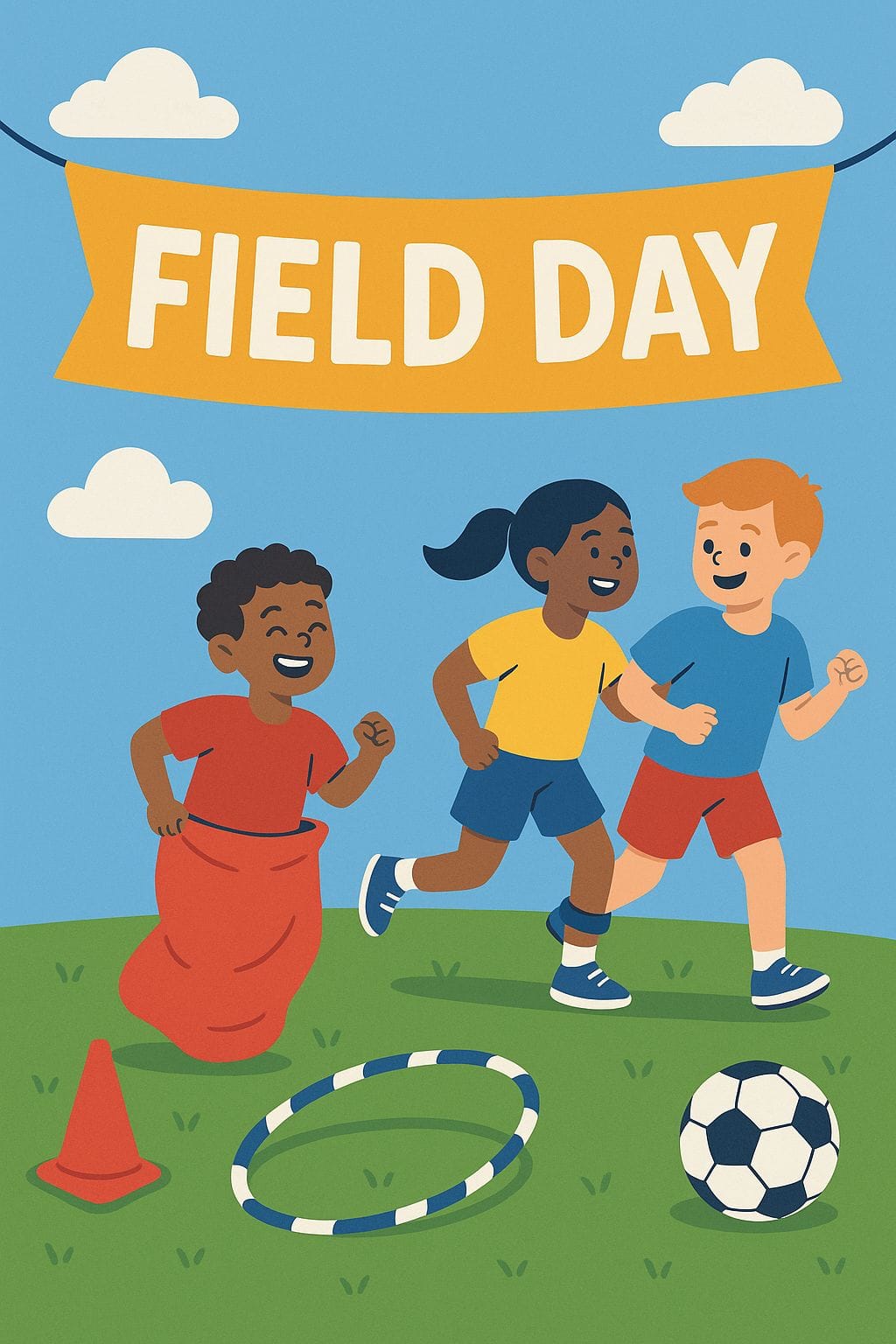Field Day Activities: Fun Ideas for Your Students

It is that exciting time of year again - field day season! For students, it is one of the most anticipated days filled with fun, laughter, and friendly competition. For teachers, however, planning the perfect field day can sometimes feel a little overwhelming. Between wrapping up lessons, organising end-of-year events, and keeping young minds engaged, adding one more thing to your to-do list can seem daunting.
Planning a memorable field day does not have to be stressful or expensive. With a little creativity and the right activities, you can create a day that your students will talk about long after the final bell rings. In this blog, you will find a variety of fun, budget-friendly field day ideas that are easy to organise and sure to bring big smiles.
What is a Field Day?
A field day is a special event usually held towards the end of the school year to celebrate all the hard work students have done. It is a day full of outdoor games, fun activities, and friendly competitions designed to give students a break from the classroom and a chance to enjoy themselves with their friends and teachers.
Traditionally, field days are packed with team games like relay races, obstacle courses, tug-of-war, and water games. The activities are often set up in different stations, and students rotate through them, either individually or in teams. Field days are not just about winning; they are about building teamwork, encouraging sportsmanship, and creating joyful memories that students will treasure for years to come.
For teachers, a field day is a wonderful way to end the year on a positive note and celebrate the achievements of their students in a relaxed and exciting environment. Whether you keep it simple or go all out with themed activities, the goal is always the same: to have fun, laugh a lot, and bring the school community together.
10 Types of Field Day Activities to Make it Memorable
Planning a field day that your students will remember for years does not have to be complicated. With the right mix of activities, you can create a day full of excitement, laughter, and teamwork. Here are 30 fun and easy ideas to help you plan a field day that is enjoyable for everyone.
1. Adventure Obstacle Challenge
Nothing brings out the spirit of adventure quite like an obstacle course. This activity is a fantastic way to challenge students’ coordination, balance, and problem-solving skills while giving them plenty of opportunities to laugh and have fun. Best of all, you can set it up indoors or outdoors, depending on the weather, and tailor it to suit your students' ages and abilities.
Supplies Needed:
- Cones
- Jump ropes
- Tables
- Balance beams
- Tumbling mats
- Hula hoops
- Small and large balls
- Themed props (optional, for added fun)
How to Play / Instructions:
- Set up a course using your equipment, creating different challenges such as weaving between cones, crawling under tables, balancing on beams, and hopping across mats.
- Add a fun twist with a theme. For example, students could become circus performers balancing "seal balls," pirates walking the plank, or jungle explorers leaping through hoops.
- To make it even more exciting, ask students to complete the course while balancing a ball between their knees or have them crab-walk their way through.
- Once they have mastered the course one way or another, challenge them to complete it in reverse to test their memory and agility.
- For smaller groups, turn it into a treasure hunt by giving each student a map and clues to find hidden prizes along the way.
2. Pizza Delivery Relay Race
Add a tasty twist to the classic relay race with this fun pizza-themed challenge. Students will need speed, balance, and teamwork to deliver their "pizza" safely across the field. It is a simple setup but guarantees plenty of laughs and excitement.
Supplies Needed:
- Empty pizza boxes
- Large cardboard circles (to represent the pizza)
- Cones
How to Play / Instructions:
- Set up cones to mark the course: one at the starting point, one at the finish line, and others at any relay exchange points you want to include.
- Divide the students into teams and give each team a pizza box with a cardboard “pizza” inside.
- Students will decide who runs each part of the course and line up at the appropriate cones.
- When you say “Go!” the first runner must move as quickly as possible with the pizza box open and the pizza balanced inside.
- At each exchange point, they must pass the pizza box carefully to the next teammate without dropping the pizza!
- The first team to deliver their pizza safely to the finish line wins.
3. Let’s Dance
Dance activities are a fun and high-energy way to let your students express themselves while also getting some exercise. Whether indoors or outside, these dance games will have your students having a blast.
Supplies Needed:
- Music (playlist or speaker)
- Open space (indoor or outdoor)
- Optional: Dance props (like scarves or hats for extra fun)
How to Play / Instructions:
Group Dance:
- Set up a few areas where groups of students can gather. Invite a brave volunteer to lead each group in a popular dance, like the Cupid Shuffle, Cha Cha Slide, or the Chicken Dance.
- Let the students learn the dance and then perform it together. You can switch the songs after a few minutes to keep things fresh and fun.
Dance Contest:
- Organise a dance contest where students compete based on endurance or skill.
- You can either give students time to prepare their best moves or have them show off their dancing talent on the spot.
- Award prizes for the best or most creative dancers.
Freeze Dance:
- Start the music and let everyone dance freely on the “dance floor.”
- At random points, pause the music, and students must freeze in whatever position they are in.
- Anyone caught moving after the music stops is out. The last person remaining wins.
Copycat Dance:
- Have everyone stand in a circle. The first student starts by doing a simple dance move.
- The next student copies the move and adds their own twist, and so on, building a chain of creative dance moves.
- This activity encourages creativity and gets everyone involved in the fun.
Limbo Dance:
- Set up a limbo stick or use a rope. Students must bend backward and dance their way under the limbo stick without touching it or falling.
- To make it more challenging, lower the stick after each round and encourage students to incorporate fun dance moves while limboing.
4. Make Something Messy
Field days are a fantastic chance to get your students' creative juices flowing, and nothing says "fun" like a bit of mess. These messy crafts are not only engaging but also allow students to express themselves artistically while enjoying the outdoors. Just make sure to have some extra cleaning supplies nearby.
Supplies Needed:
- Paint (finger paints, watercolors, acrylics)
- Bubbles (bubble solution and dish soap)
- Sidewalk chalk
- Tissue paper squares
- Glue mixture (½ cup craft glue, ¼ cup water)
- Craft objects (flower pots, boxes, etc.)
- Marbles
- Leaves (optional for leaf prints)
- Large sheets of paper or poster boards
- Towels or wipes for cleanup
How to Play / Instructions:
Finger Painting:
- Set up designated craft stations outside. Each station should have finger paints, large sheets of paper, and smocks (if needed).
- Let the students dive in and create their own unique art by painting with their fingers. You can provide various themes or simply let their imagination run wild.
- Make sure to have space to dry their artwork afterward.
Sidewalk Chalk:
- Provide students with sidewalk chalk and encourage them to create beautiful drawings, games (like hopscotch or Four Square), or even a giant mural together.
- You can also turn it into a challenge, such as who can draw the most intricate design or complete a chalk puzzle.
Paint with Bubbles:
- Mix bubble solution with a few drops of watercolor to create colourful bubbles.
- Give each student a piece of paper and allow them to blow the bubbles onto it. The bubbles will burst, leaving behind a fun and colourful pattern.
- This is a great way for students to experiment with colours and see how the paint blends.
Leaf Prints:
- Let students gather leaves from nature or provide a selection of leaves.
- Dip the leaves in paint and press them onto paper to create nature-inspired prints.
- For an added twist, you can let students combine the leaves with other materials, like tissue paper or markers, to enhance their artwork.
5. Jump Through Hoops
Hoops are not just for hula dancing. These activities combine fun and fitness, encouraging students to showcase their coordination, teamwork, and stamina. Perfect for keeping kids active and engaged, these hoop-based games will definitely get them moving and laughing.
Supplies Needed:
- Hula hoops
- Frisbees
- Cones
- Balls (soccer balls, softballs)
- Dowel rods (for securing hula hoops in the ground)
- Music player (for Musical Hoops)
How to Play / Instructions:
Hula Hoop Marathon:
- The objective is simple: who can keep their hula hoop spinning the longest?
- Students will try to keep the hoop moving around their waist, arm, or leg.
Hula Hoop Ring Toss:
- Set up 15–20 cones spread out over a large open space.
- Students will try to toss hula hoops over the cones.
- To increase the difficulty, have them start closer and gradually move further back.
- You can also add a point system based on how many hoops they get over different cones.
Frisbee Throw:
- Set up hula hoops at varying distances and angles.
- Participants must throw a frisbee through the hoops, aiming for the targets while increasing the challenge by adjusting the distance.
- This activity helps students improve their aim and precision while staying active.
Hula Hoop Soccer:
- Take the fun of soccer and combine it with hula hoops.
- Cut the hula hoops in half and insert dowels into the ground to create goalposts.
- Students will kick soccer balls through the hoops to score points.
- You can play in teams or as individuals.
Musical Hoops:
- This game works just like musical chairs but with hoops instead of chairs.
- Play music while students walk around the hoops. When the music stops, students must quickly find and hop into a hoop.
- If two students end up in the same hoop, the one who touched it first gets to stay in while the other is out.
6. Last One Standing
Sometimes, the best way to break up a day of physical activity is with a mental challenge. Last One Standing is a fantastic field day game that tests your students’ vocabulary skills while encouraging quick thinking and sharp minds. This activity will also encourage students to improve their speaking and listening skills.
Supplies Needed:
- A large open space (indoors or outdoors)
- A list of categories (e.g., animals, countries, food, objects)
- A timer (optional)
How to Play / Instructions:
Set Up Categories:
- Choose a variety of categories that suit the age group and interests of your students.
- Write the categories on a board or a large piece of paper so everyone can see.
Gather the Students:
- Have all the students gather in a circle or line.
- The game can be played with the whole class or in small groups, depending on the number of students.
Start the Game:
- Call out a category, such as "animals."
- The first student in line must quickly name an animal. The next student must name a different animal, and so on.
- The catch is that no one can repeat an answer. If a student repeats a word or takes too long to come up with one, they are out.
Keep Going:
- Continue playing until only one student remains standing in the game.
- You can also set a timer for each round to add a sense of urgency and speed up the game.
Variation:
- To make it even more challenging, introduce additional categories that require specific criteria.
- For example, “name an animal with more than four legs,” or “name a fruit that starts with the letter 'P.’”
7. Cheeseball Challenge
The Cheeseball Challenge is a hilarious activity that is guaranteed to bring out the laughs and excitement. This game is perfect for bringing some light-hearted competition to your field day, and it is just messy enough to make it unforgettable.
Supplies Needed:
- Shower caps (1 per group)
- Shaving cream
- Cheeseballs or cheese puffs
- Timer or stopwatch
How to Play / Instructions:
- Break your students into groups, each with a shower cap and a few bags of cheeseballs. Make sure you have enough space for everyone to play.
- Each team must choose one student to wear the shower cap. This person will be the target of the cheeseball toss.
- The designated student gets to cover their shower-cap-wearing head with shaving cream.
- Once the student is ready, the rest of the team will get in position.
- The goal is for the teammates to throw cheeseballs at the student’s head and try to get as many cheeseballs to stick to the shaving cream as possible.
- Set a timer for one minute. The team with the most cheeseballs stuck to the shaving cream after time is up wins.
8. Field Day T-shirt Decorating
Add a creative twist to your field day with the Field Day T-shirt Decorating activity. Not only will this give your students a chance to express their artistic side, but it will also create lasting memories they can wear proudly long after the day is over.
Whether you are looking for a fun art project or a memento for the class, this activity is an excellent way to combine creativity with a bit of science. In case of bad weather, you can also organise this activity indoors and also enhance it with classroom door decoration with a sample painted shirt.
Supplies Needed:
- Plain white T-shirts (one for each student)
- Permanent markers (variety of colours)
- Spray bottles filled with isopropyl alcohol
- Plastic tablecloths or drop cloths (to protect surfaces)
How to Play / Instructions:
- Give each student a plain white T-shirt to decorate. Make sure to have plastic coverings on the surfaces to protect from any marker stains.
- Provide permanent markers in a variety of colours and let students go wild with their designs.
- They can draw patterns, write names, or create pictures that represent their field day memories.
- Once the students have finished their designs, give them spray bottles filled with isopropyl alcohol.
- When sprayed on the permanent marker designs, the alcohol will cause the ink to bleed and create a tie-dye effect, which looks fantastic and unique for each shirt!
- For safety, make sure students are spraying at a safe distance from each other. You might want to demonstrate first how to spray the shirts to create the best effect.
- After the spray bottles have done their work, leave the shirts to dry. Be sure to tell the students that they should not touch their designs until the shirts have dried completely.
Alternative Option – Memory Signing:
If you are concerned about students spraying alcohol in each other’s vicinity, you can turn this activity into a memory-making project. Have the students sign each other’s T-shirts with permanent markers. This can be a great way for them to remember their classmates and the fun field day they shared.
9. Pillowcase Races
Get ready for some good old-fashioned fun with the Pillowcase Races. This game is a classic twist on the traditional potato sack race but with a creative and budget-friendly spin. It is a perfect activity to bring out the competitive spirit in your students while giving them a good laugh. All you need is a few old pillowcases, and you are ready to go.
Supplies Needed:
- Old pillowcases (one per student)
- Cones or markers to set up race boundaries
- A whistle or timer (optional, to time each race)
How to Play / Instructions:
Set Up the Course:
Mark a start and finish line using cones, ropes, or any available materials. The race can be as short or as long as you like, depending on your available space.
Distribute the Pillowcases:
Give each student a pillowcase to slip into. They should stand inside the case with both feet inside the pillowcase. The race is on once the whistle blows.
Race Time:
At the sound of the whistle, the students must hop to the finish line, trying to avoid falling over. They cannot use their hands for assistance; it is all about hopping and balance.
Add Extra Fun:
For a fun twist, consider making the race even more challenging by adding obstacles along the way, like cones to weave through or requiring students to hop on one foot at certain points.
Time the Races:
If you have multiple students participating, you can time each race and set up heats to determine who the fastest pillowcase racer is. Or, if you prefer, just make it a fun, non-competitive activity where everyone gets to race.
Cheer Them On:
Encourage everyone to cheer for their classmates, making it a positive and exciting experience for all. The laughter and energy will surely make this a memorable event.
10. Fill the Bucket
The goal of this game is for students to race against each other to transfer water from one bucket to another using only a sponge. This activity is not only fun and competitive, but it also helps develop coordination and teamwork among students.
Supplies:
- Two small buckets (which can be bought at a dollar store or found at home)
- A large sponge (one for each team or group, depending on the number of students)
- Water to fill one of the buckets
Instructions:
- Position the two buckets a few feet apart. Fill one bucket with water (this will be the "full" bucket), and leave the other empty (the "empty" bucket).
- Divide into Teams: Split the students into teams. Each team gets one sponge to use to transfer water.
- Students dip the sponge into the full bucket, soaking up as much water as possible. Then, they race to the empty bucket and squeeze the water into it.
- Give each team a set time (usually 2 minutes), or let the activity continue until one team fills their bucket up to a predetermined line.
- The team that fills their bucket first or gets the most water transferred within the time limit wins the game.
Tips to Organise Field Day Activities Smoothly
Planning and organising a successful field day can be a lot of work, but with the right preparation and tips, you can make the event run smoothly and ensure that everyone has fun. Whether it is your first time organising or you are a seasoned pro, these tips will help you stay on track and create an exciting and memorable experience for your students.
1. Plan Ahead
The key to a smooth field day is preparation. Start planning well in advance so you have enough time to gather supplies, organise volunteers, and set up the event.
Break down the day’s activities into a well-organised schedule, listing each game, its duration, and the groups involved. Make sure to account for breaks and lunch periods.
Assign clear roles to your helpers, whether they are teachers, parent volunteers, or older students. Having a volunteer for each activity or station will make things much easier.
2. Group Students Effectively
Field day is all about teamwork, so it is important to group students in a way that promotes cooperation, fairness, and fun. Mix up the students by age, ability, or even class. This ensures that no one team has an unfair advantage, and it fosters friendships between students who do not usually interact. It is always a good idea to have some fun icebreakers for students at the start of the day.
Make sure each group is large enough for a good competition but not so large that students cannot actively participate in every activity. For certain activities, it is helpful to assign roles to each student. For example, in a relay race, one student can run, another can hand off the baton, and a third can track the team’s time.
3. Choose the Right Activities
A well-organised field day needs a variety of activities that keep students engaged while also catering to different interests and physical abilities. Include both high-energy games like relay races and quieter ones, like arts and crafts, to cater to different energy levels and give kids a break when needed. You can also consider creating calming corners for such students.
Be sure to include games that are accessible to all students. Consider modifying activities to suit different skill levels, such as adjusting the difficulty of an obstacle course. Games that require collaboration, like team relays or group problem-solving tasks, will help foster teamwork and create a sense of community.
4. Set Up Stations
Setting up distinct activity stations ensures that students can easily navigate from one activity to the next without confusion. Use cones, signs, or colored tape to demarcate each activity station clearly. Make sure there is a visual cue for where each game is happening.
Have one volunteer or teacher stationed at each activity to oversee the game, explain the rules, and keep things moving. This will help maintain the flow and reduce confusion. Set up stations far enough apart so students are not crowding each other.
5. Prepare for Weather Conditions
Weather can make or break your field day. If you are planning an outdoor field day, always have an indoor option ready in case of bad weather. A good option for such a day can be fun and interactive library activities. Alternatively, have tents or canopies on hand to provide shade if it is too hot.
Make sure to monitor the weather leading up to the day. Consider rescheduling or moving some activities indoors if rain is forecast. On hot days, it is essential to keep students hydrated. Set up water stations and encourage students to drink water throughout the day. In such unexpected weather conditions, you can also consider organising indoor recess games.
6. Manage Transitions Between Activities
Keep the energy high and prevent downtime by managing transitions smoothly. Limit the time between each activity to keep students engaged. Consider using a whistle or bell to signal the start and end of each game.
Before each activity begins, quickly gather the students and explain the rules to avoid confusion during the game. Ensure that each group knows where to go next by giving them a rotation schedule or map.
7. Provide Safety and First-Aid Measures
Field day is full of energetic activities, so safety is a top priority. Make sure you have a well-stocked first-aid kit available, as well as staff or volunteers trained to deal with minor injuries like scrapes or sprains.
Make sure there is enough supervision at each station. Having plenty of eyes on the students will help prevent accidents and ensure the event runs smoothly. Be aware of any students with allergies or special needs.
8. Consider a Reward System
End the day on a high note with rewards or recognition for students who demonstrate teamwork, sportsmanship, or creativity. Hand out small prizes or certificates to participants in each game. This gives kids a sense of accomplishment and encourages everyone to get involved.
Consider giving a “Best Team Spirit” award or “Most Cooperative Team” to encourage positive behavior and teamwork. Make sure every student feels appreciated, whether they win or not. This will help build confidence and make the day enjoyable for all.
9. Capture the Moments
Field day is a special event, so it is a good idea to capture the memories. Assign one or two volunteers or teachers to take photos throughout the day. These pictures can be shared with parents, included in school newsletters, or displayed around the classroom.
If possible, take short video clips of students participating in the activities. This can be a great way to recap the day and highlight everyone’s hard work.
10. Reflect and Get Feedback
After the event, take some time to reflect on what went well and what could be improved for next year. Gather feedback from students, staff, and volunteers about what they enjoyed and what could be improved. This will help you plan an even better field day next time.
Acknowledge the hard work of all the volunteers and staff who helped organise and run the event. Their efforts are essential to making field day a success. By following these tips, you will be able to create a smooth, organised, and enjoyable field day that your students will remember fondly.
Conclusion
Field day is an exciting and memorable event for students, providing a chance to celebrate the end of the school year with fun activities, teamwork, and a break from the classroom routine. While organising field day can seem overwhelming, with proper planning and a little creativity, you can create an event that runs smoothly and is enjoyable for both students and staff.




